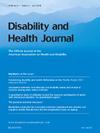Self-reported hearing loss and health during a pandemic: Findings from a cross-sectional analysis using a 2021 household survey
IF 3.7
2区 医学
Q1 HEALTH CARE SCIENCES & SERVICES
引用次数: 0
Abstract
Background
The COVID-19 pandemic differentially impacted individuals with hearing loss, likely in part due to increased communication difficulties from masking, a commonly implemented protective measure.
Objective
This study examines the association between self-reported hearing loss and health during the pandemic.
Methods
This study uses data from the COVID-19 Survey collected by the Survey of the Health of Wisconsin from February to March 2021. Hearing loss was defined as self-reported fair or poor hearing. The outcomes were self-reported symptoms of anxiety and depression, separately, and self-reported general health. Multivariable models adjusted for age, gender, and race/ethnicity were used to examine the associations between hearing loss with each outcome. Results are presented as prevalence ratios (PR) with corresponding 95 % confidence intervals (CI).
Results
There were 1857 participants (60.3 % female, 12.9 % non-white) with a mean age of 57.1 years in this cross-sectional study. In multivariable models, individuals with hearing loss (versus none) had higher prevalence of depression (PR: 1.22, 95 % CI: 1.06, 1.39), anxiety (PR: 1.13, 95 % CI: 1.02, 1.27), and self-reported fair or poor health (PR: 2.61, 95 % CI: 1.89, 3.61).
Conclusion
Hearing loss was associated with poorer self-reported health during winter 2021 of the COVID-19 pandemic, when mask use in public was newly mandated and vaccines were not widely available to the general public. Further research on the impact of public health policies on vulnerable populations, including those with hearing loss, is warranted. Such research could inform policy decisions that accommodate these populations.
自我报告的听力损失与大流行期间的健康状况:利用 2021 年家庭调查进行横断面分析的结果
COVID-19 大流行对听力损失患者造成了不同程度的影响,部分原因可能是由于掩蔽这一普遍采用的保护措施增加了交流困难。本研究探讨了大流行期间自我报告的听力损失与健康之间的关系。本研究使用的数据来自威斯康星州健康调查局于 2021 年 2 月至 3 月期间收集的 COVID-19 调查。听力损失被定义为自我报告的听力一般或较差。结果分别为自我报告的焦虑和抑郁症状,以及自我报告的一般健康状况。使用调整了年龄、性别和种族/族裔的多变量模型来研究听力损失与各项结果之间的关联。结果以患病率比 (PR) 和相应的 95 % 置信区间 (CI) 表示。这项横断面研究共有 1857 名参与者(60.3% 为女性,12.9% 为非白人),平均年龄为 57.1 岁。在多变量模型中,听力损失患者(与无听力损失患者相比)的抑郁(PR:1.22,95 % CI:1.06,1.39)、焦虑(PR:1.13,95 % CI:1.02,1.27)和自我报告的健康状况一般或较差(PR:2.61,95 % CI:1.89,3.61)发生率较高。在 COVID-19 大流行的 2021 年冬季,听力损失与自我报告的健康状况较差有关,当时新规定在公共场合使用口罩,而疫苗尚未向公众普及。有必要进一步研究公共卫生政策对弱势群体(包括听力损失者)的影响。此类研究可为适应这些人群的决策提供参考。
本文章由计算机程序翻译,如有差异,请以英文原文为准。
求助全文
约1分钟内获得全文
求助全文
来源期刊

Disability and Health Journal
HEALTH CARE SCIENCES & SERVICES-PUBLIC, ENVIRONMENTAL & OCCUPATIONAL HEALTH
CiteScore
7.50
自引率
6.70%
发文量
134
审稿时长
34 days
期刊介绍:
Disability and Health Journal is a scientific, scholarly, and multidisciplinary journal for reporting original contributions that advance knowledge in disability and health. Topics may be related to global health, quality of life, and specific health conditions as they relate to disability. Such contributions include:
• Reports of empirical research on the characteristics of persons with disabilities, environment, health outcomes, and determinants of health
• Reports of empirical research on the Systematic or other evidence-based reviews and tightly conceived theoretical interpretations of research literature
• Reports of empirical research on the Evaluative research on new interventions, technologies, and programs
• Reports of empirical research on the Reports on issues or policies affecting the health and/or quality of life for persons with disabilities, using a scientific base.
 求助内容:
求助内容: 应助结果提醒方式:
应助结果提醒方式:


